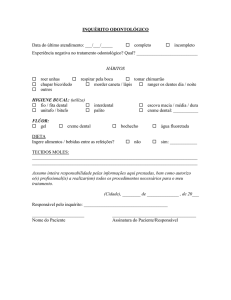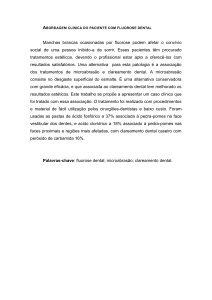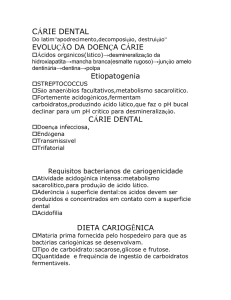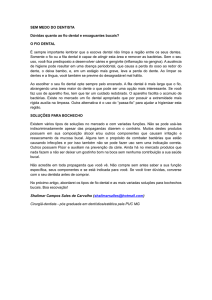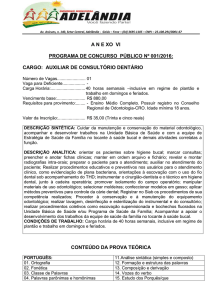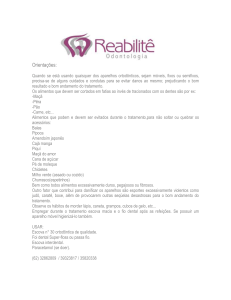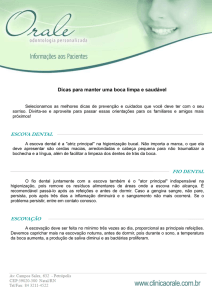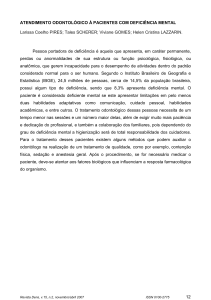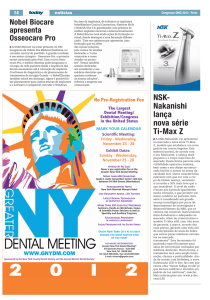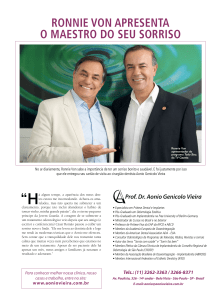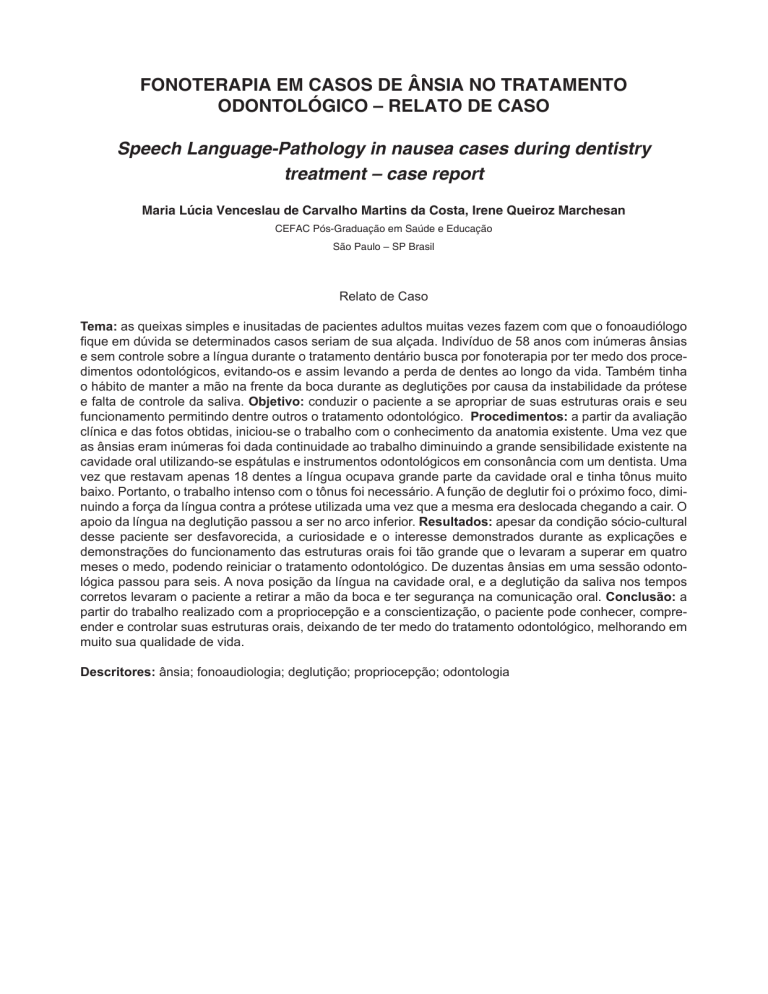
FONOTERAPIA EM CASOS DE ÂNSIA NO TRATAMENTO
ODONTOLÓGICO – RELATO DE CASO
Speech Language-Pathology in nausea cases during dentistry
treatment – case report
Maria Lúcia Venceslau de Carvalho Martins da Costa, Irene Queiroz Marchesan
CEFAC Pós-Graduação em Saúde e Educação
São Paulo – SP Brasil
Relato de Caso
Tema: as queixas simples e inusitadas de pacientes adultos muitas vezes fazem com que o fonoaudiólogo
fique em dúvida se determinados casos seriam de sua alçada. Indivíduo de 58 anos com inúmeras ânsias
e sem controle sobre a língua durante o tratamento dentário busca por fonoterapia por ter medo dos procedimentos odontológicos, evitando-os e assim levando a perda de dentes ao longo da vida. Também tinha
o hábito de manter a mão na frente da boca durante as deglutições por causa da instabilidade da prótese
e falta de controle da saliva. Objetivo: conduzir o paciente a se apropriar de suas estruturas orais e seu
funcionamento permitindo dentre outros o tratamento odontológico. Procedimentos: a partir da avaliação
clínica e das fotos obtidas, iniciou-se o trabalho com o conhecimento da anatomia existente. Uma vez que
as ânsias eram inúmeras foi dada continuidade ao trabalho diminuindo a grande sensibilidade existente na
cavidade oral utilizando-se espátulas e instrumentos odontológicos em consonância com um dentista. Uma
vez que restavam apenas 18 dentes a língua ocupava grande parte da cavidade oral e tinha tônus muito
baixo. Portanto, o trabalho intenso com o tônus foi necessário. A função de deglutir foi o próximo foco, diminuindo a força da língua contra a prótese utilizada uma vez que a mesma era deslocada chegando a cair. O
apoio da língua na deglutição passou a ser no arco inferior. Resultados: apesar da condição sócio-cultural
desse paciente ser desfavorecida, a curiosidade e o interesse demonstrados durante as explicações e
demonstrações do funcionamento das estruturas orais foi tão grande que o levaram a superar em quatro
meses o medo, podendo reiniciar o tratamento odontológico. De duzentas ânsias em uma sessão odontológica passou para seis. A nova posição da língua na cavidade oral, e a deglutição da saliva nos tempos
corretos levaram o paciente a retirar a mão da boca e ter segurança na comunicação oral. Conclusão: a
partir do trabalho realizado com a propriocepção e a conscientização, o paciente pode conhecer, compreender e controlar suas estruturas orais, deixando de ter medo do tratamento odontológico, melhorando em
muito sua qualidade de vida.
Descritores: ânsia; fonoaudiologia; deglutição; propriocepção; odontologia
SPEECH LANGUAGE-PATHOLOGY IN NAUSEA CASES DURING
DENTAL TREATMENT – CASE REPORT
Fonoterapia em casos de ânsia no tratamento odontológico –
relato de caso
Maria Lúcia Venceslau de Carvalho Martins da Costa, Irene Queiroz Marchesan
CEFAC Pós-Graduação em Saúde e Educação
São Paulo – SP Brasil
Relato de Caso
Theme: simple and unusual complaints of adult patients may cause the speech therapist to question
whether some cases should be treated by him/ her or by other professionals from different areas. A 58-yearold subject suffering from nauseas and having no control over the tongue during dental treatment searched
for speech therapy. His fear of dental procedures caused him to avoid treatment, leading to loss of teeth.
Having only 18 teeth, the patient used to cover his mouth with a hand during swallowing due to the instability
of the prosthesis and lack of control of saliva. Purpose: to lead the patient to understand and take control of
his oral structures as well as their functioning in order to make dental treatment possible. Procedures: the
therapy started showing the patient the photos of his oral anatomy. Spatulas, liquids and dental instruments,
according to a dentist’s orientation, were used to diminish the high sensitivity of the oral cavity. The tongue
occupied a large part of the oral cavity, and had very low tone. Therefore, extensive work with the tone
was necessary. The improvement of the swallowing function was the next focus. The support of the tongue
in swallowing changed to the lower arch, decreasing, in this way, the strength of the tongue against the
prosthesis, which used to fall. Results: despite the low socio-cultural condition of that patient, the interest
demonstrated during the explanations of the oral structures functioning was so great that it took him four
months to overcome fear and restart the dental treatment. The patient, who had about two hundred nauseas
during one dental session, had its number reduced to six. As a result of the new tongue position and the
correct timing in swallowing saliva, the patient abandoned the habit of covering his mouth and became
more confident in oral communication. Conclusion: after a proprioceptive work, and self understanding, the
patient was able to comprehend and manage his oral structures, overcame the fear of dental treatment, and
had his quality of life greatly improved.
Keywords: nausea; speech-language pathologist; deglutition; dental treatment

